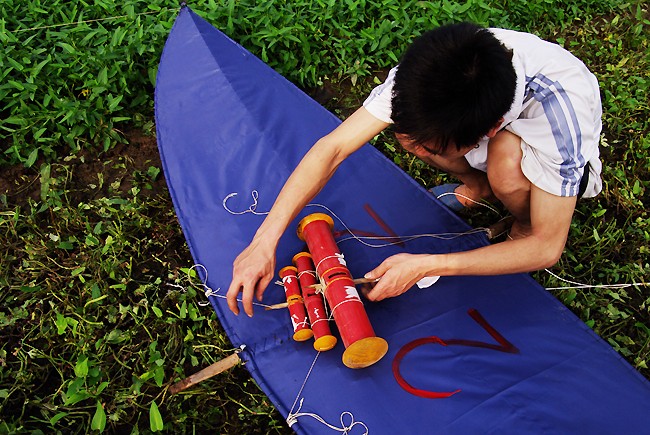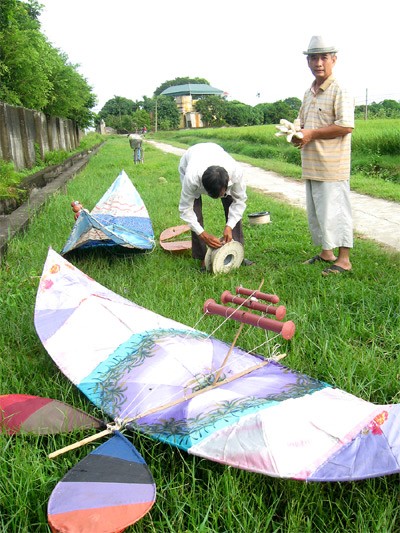Hello and welcome to VOV’s Letter Box, our weekly feature dedicated to listeners throughout the world. We are Mai Phuong and Ngoc Huyen.
A: First on our show today, we’d like to thank you all, our dear listeners throughout the world for regularly tuning in to our programs. The number of letters and emails that we received increased significantly this week indicating an increasing interest in Vietnam, its land and people.
B: The increase also shows that D’xing is still popular throughout the world. We have received letters from the US, the UK, Brazil, Germany, Italy, Spain, Australia, Sweden, Portugal, India, Bangladesh, Indonesia, Singapore and many other places.
A: From Nigeria, Sanusi Isah Dankaba sent us an email saying he is eager to show off his knowledge of Vietnam and asking whether VOV will conduct a contest about Vietnam next year.
B: So far, VOV has organized 4 contests called “What do you know about Vietnam” for foreign listeners around the world. The contest has been held every five years since 1995. All the contests have received a good response from our listeners.
A: The most recent “What do you know about Vietnam” contest was held in 2010. In that contest, we presented prizes to 14 outstanding entries.
B: Tokita Michia of Japan won first prize. Idriss Bououdina of Morocco received second prize. Two third prizes, ten consolation prizes, and three special prizes were also awarded.
A: The contest attracted more than 200 entries from listeners in 28 countries. The contestants answered five questions about Vietnam related to Vietnam’s role in the UN Security Council, outstanding achievements of Vietnam in 2009, Vietnam’s tangible and intangible Heritage of Humanity recognised by UNESCO, the 1000th birthday of Thang Long-Hanoi, and the 65th anniversary of VOV in 2010.
B: So, yes, our next “What do you know about Vietnam” contest is supposed to be held next year, but our plans are not definite yet. As soon as we have information about the contest, we’ll inform you. Hopefully, you, our dear listeners will once again display your broad knowledge of and interest in Vietnam.
B: This week, SB Sharma of India sent us an email expressing her interest in VOV’s beautiful pictures of kite flying in Hue city. She wrote: “The Vietnamese sky is full of colorful kites”. Sharma enjoyed the story about making and flying kites in Hue city.
A: Well, not only in Hue, anywhere in Vietnam, you will have a chance to experience “diều sáo”- kite flying with flute singing.![Wednesday, May 22, 2014 - ảnh 2]() Kite flying is popular throughout the year, but especially in summer. Vietnamese people of all ages make kites of many shapes, sizes, and materials with bamboo flutes attached. “Diều sáo” are interesting for their shapes and colors and also for their flutes. Every afternoon, when the wind begins to blow, you can enjoy the magical sound created by of the “Dieu sao” flutes.
Kite flying is popular throughout the year, but especially in summer. Vietnamese people of all ages make kites of many shapes, sizes, and materials with bamboo flutes attached. “Diều sáo” are interesting for their shapes and colors and also for their flutes. Every afternoon, when the wind begins to blow, you can enjoy the magical sound created by of the “Dieu sao” flutes.

Photo: vietnambeauty.com |
A: “Diều sáo” made in the traditional Vietnamese style have eight ovoid wings with five bamboo flutes in graduated sizes mounted on top. These make a pleasant drone when the kite is flying. The faster the kite swoops, the more exciting is the sound of the flutes.
B: Children's kites are usually small, simple and covered with paper, while kites for adults are more complex, often cloth-covered, and feature one or more flutes that whistle as the kites fly.
A: A typical adult kite has four parts: the body, the steering string, the flying string and the flutes. The frame is made of smooth bamboo stalks and is well polished. Kite-makers shape bamboo strips into a crescent two to three metres long and one metre wide. After that, they cover the frame with pieces of cotton cloth or carefully glued paper. If one half of the kite is heavier than the other, the steering string will help balance it. This string also serves to direct flight and protect the kite wings from breaking if the wind is too strong. The flying string is also made of bamboo and can be as long as 100m or 150m.
B: Flutes of different sizes and materials can reproduce the sound of birds, car horns, gongs or music. The mouth of the flute must be skillfully carved so that will catch the wind and create the desired sound.

Photo: vietnambeauty.com
|
A: Today, villagers build more sophisticated kites in the shape of phoenixes, butterflies and dragons. They replace thick bamboo strings with thinner bamboo or plastic strings. Modern kites are very light and cost little since the materials to make them are readily available.
B: The Vietnamese usually fly “diều sáo” in the late afternoon as the sun begins to set. Normally, two people fly one kite. One person holds the flying string while the other takes the kite and runs into the wind until the wind lifts the kite. They take turn to keep the kite high in the sky day after day. Sometimes from summer to autumn. Estimated to be some 2,000 years old, “diều sáo" are popular all over Vietnam, where kite flying is considered as a sport, a hobby and a religious custom.

Photo: vietnambeauty.com
|
B: This week, we’d like to welcome back Christopher Lewis of England. We were glad to hear from you again, Christopher. Christopher reported listening to our program on April 9th on the frequency of 9730 from 19:00 to 19:27 UTC and rated SINPO at 45444. He wrote: “Reception of your transmission is excellent via the VOV transmitters in Vietnam. 9730 khz provides excellent reception, overall SINPO is mainly 4’s and 5’s”.
A: Thank you, Christopher. We’ll send you our QSL card to confirm your listening. Also this week, we received some small gifts from Cheng Nan Lu of Taiwan. He sent us some beautiful souvenirs from Radio Taiwan International and a reception report on April 12 on the frequency of 9840 khz. We like your gifts very much, Cheng Nan Lu.
B: From Sweden, Jan Gorlin sent us a letter enclosed with a reception report on our program on March 6 and a CD of the program. Jan wrote: “I am a listener to distant radio station, a D’xer since1962. Nowadays, the number of D’xers is decreasing. Younger people use the internet without disturbance. Still I find it exciting to catch far distant radio stations from all over the world and get a confirmation from the station that I really heard them”.
A: Yes, it’s true that there are more and more media available now, but shortwave provides an informative channel and also an enjoyable hobby for many people around the world.
B: Our time is running out. In the final minutes of our show today, we’d like to confirm reception reports from Hannu Kiiski of Finland, Alan Fenix of the US, Vijaya Krishna Bhat, Karobi Hazarika, Neelakadan Visvanathan of India, Fachri and Tjang Pak Ning of Indonesia, Rafiqul Islam andRajib Kumar Mondal of Bangladesh, Andrej Kuznesovs of Latvia, David Ansell of England, Flavio Cardone of Poland and Scalione Massimo of Italy, and Fumitomo Hokamura and Nishizawa Kazuhiro of Japan. We’ll send you QSL cards and souvenirs you requested as soon as we can.
A: We welcome your feedback at: English section, Overseas Service, Radio Voice of Vietnam, 45 Ba Trieu Street, Hanoi, Vietnam. Or you can email us at: englishsection@vov.org.vn. You’re invited to visit us online at www.vovworld.vn, where you can hear both live and recorded programs. Good bye until next time.